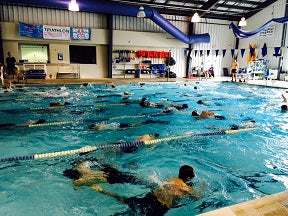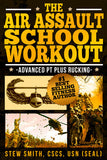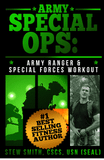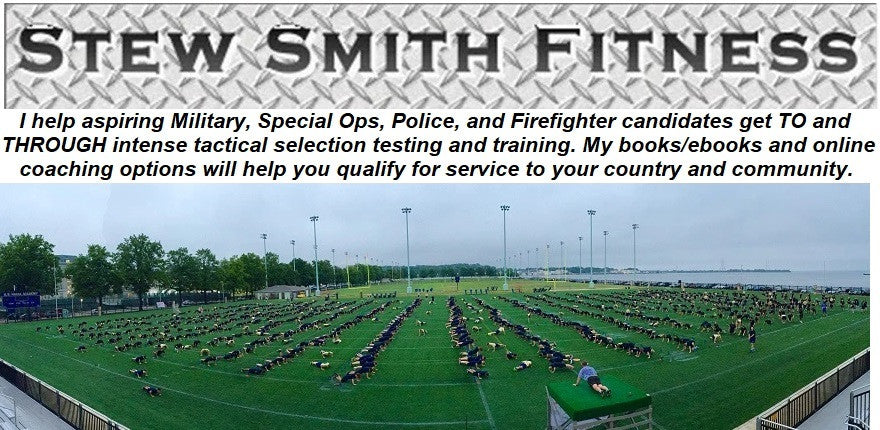What is Optimal? You and Your Efforts
Determine What Works for You Best
When we are training for a specific goal, we seek programming and personalized workouts that we hope will yield optimal results. Typically, most programming can yield above average results if consistently applied into a long-term system of proven applications, but what is the optimal method for you, may need some changes for others to see the same results. These improvements come through personally testing and evaluating different methodologies, training systems, and individual workouts as well.

As a trainer for men and women who seek advanced levels of fitness in preparation for the tactical professions, I have seen people make common mistakes. They are simply explained – either they did too much or not enough – period. Now – this applies to EVERYTHING and all elements of fitness and finding the right balance is relative and different for everyone. My Tactical Fitness Periodization System allows for that delicate balance between too much and not enough with 20 years of use, practice, changes, and advancements.
Remember in the tactical professions, becoming a tactical athlete means you need to have a solid foundation in all the elements of fitness (above). That means the strength / power athletes need some muscle stamina and cardio endurance (running, rucking, swimming) as well as their overall work capacity for longer physical events that start in the day and keep going into the evening. It also means the endurance athletes need to work on their strength / power as well and overall durability for load bearing activities.
Turning weaknesses into strengths is a journey and typically not fun for an athlete who is really good or even great at one thing and who fails miserable at another. For instance, the competitive swimmer who needs to lift more and run more (smartly and progressively) and not spend hours in the pool each day perfecting his/her strengths. Or the power lifter who is afraid of losing gains in the gyms when he has to start running and swimming long distance. These two types of athletes come to the table with obvious strengths and easy to fix weaknesses that requires time and effort doing things they are not good at doing. Improvement in these weaknesses will be equally rewarding if not more to the athlete as I have seen some swim across a pool for the first time ever then keep training and become Navy SEALs. That is rewarding for both coach and student.
See swimming common errors if swimming is a weakness.

Common Errors - Doing TOO MUCH or NOT ENOUGH
Here is what happens typically when you do TOO MUCH or NOT ENOUGH of anything:
Ignoring weaknesses come at a cost that is usually not fully discovered until you are in your first week of real selection training. These weaknesses are usually exposed in the first few days and you have to live with failing to meet the standard or barely surviving on pure will and daily gut checks. One is devastating and the other is exhausting both physically and mentally. Don’t be the guy who did not prepare properly and did too little of the things you knew you were not good at doing.
Sometimes you will test yourself with tough workouts and border on doing too much and that is fine. Maybe you will even test your mental toughness by doing a gut check event. These have their time and place if you want to test your abilities with an endurance event (triathlon, marathon, adventure race, etc), but realize these events come with a price typically. After these events, running for a few months is reduced due to aches and pains of the event or a recovery phase that requires it. You may even break yourself as hips, shins, knees can get inflamed with tendonitis and bones can be stressed and even fracture. If you are close to your selection start date, you could be taking these injuries into a program that could re-injure them. Don’t be the guy who breaks himself and fails easily passable events just because of your injuries and de-conditioning caused by them. Either of these can lead to below optimal performance or reduced optimal performance as you will see in the spectrum below:

Sub-Optimal – Neglected Weaknesses
Your body and its capabilities are underutilized. Your strengths may be good to go however, you have elements of fitness that are working inefficiently and could produce better overall results if you had specific training programs that focus on maintaining strengths and building weaknesses into strengths. By increasing your efforts into one or more of your weaknesses, you can get more out of your body and produce better overall results that can get you TO and THROUGH the training.

Optimal – The Best You Can Be – Perfectly Balanced Strengths / Weaknesses
Your body is producing at full capability and efficiency. This means that there are no elements of fitness that you have not prepared or left to chance. Assess yourself as you need to know when you are here and able to not only reach optimal scores to get TO the training (PST), but also reaching above average scores in events that will be tested in order to get THROUGH the training. Once you are here, maintain as needed, but taper down a notch if you have significant time before you start selection. Usually, peaking like this is perfect right before Basic Training as that will be a natural taper time – then you can use the Prep Course as a way to rebuild to where you were instead of being pushed to new levels before selection.

Diminishing Returns – Burned Out on Strengths and Weaknesses – Over Prepared
Eventually, over-training symptoms start to appear and your body has stopped producing at its optimal state and you have lost capability and efficiency that is really a central nervous system overload. You have either over trained or under recovered. Recovery is EVERYTHING when you are striving to be optimal in your performance as a few bad meals, a few bad night’s sleep, and being under-hydrated can start you on this downward slope of performance even if you are not over-training. Regardless, your body cannot adjust to all of the input being given, and so you will start to see diminishing returns no matter the effort given – until you have properly recovered.

See Tactical Fitness Report on Recovery with Stew Smith and Jeff Nichols
Assess Yourself Before Your Wreck Yourself
Learn how to assess yourself as a candidate throughout the process of preparing to get TO and THROUGH the training. Not just as an initial assessment, but this chart can help you see where you meet up on the spectrum of training that will place you in the top 25% of candidates in spec ops selection programs. See Assessment tool article and video to help.
Related Articles:
Spec Ops Candidates – Is This Your Story?
Be a Better Recruit / Candidate
Spec Ops Prep – One Stop Shop Research Article
Don’t Set a Timeline to Join - Set a Performance Starting Line
Asking Great Questions if You Need Assistance
What is StewSmithFitness.com – Specific Training for Tactical Professions
Complete List of Books, eBooks, Training Programs
New Rules for Tactical Fitness Over 40+
Change is Inevitable – Growth is Not
There is More to StewSmithFitness.com Than You May Know
Dive deeper into the world of Tactical Athlete training and mental toughness by exploring Stew Smith Fitness Programming for the Tactical Athlete online store. Uncover the strategies and techniques used by elite forces to push past physical and mental barriers. Visit https://www.stewsmithfitness.com now and equip yourself with the tools for success for many special ops level selection programs in the military and police world.
New Tactical Fitness Training Course!
Getting TO the training does not guarantee you get THROUGH the training. Learn about the two phases of tactical fitness you need to develop thoroughly before getting to BUDS. Check out the Online Course - Getting TO and THROUGH Special Ops Selection.
Who is Stew Smith? Coach, Trainer, Author, Podcaster
I'm the former Navy SEAL that special ops candidates go to for books, ebooks and online coaching to prepare themselves to get to and through intense tactical assessment and selection programs and qualify for service in their chosen tactical profession. See More at StewSmithFitness.com
Where to Find More Information About Optimal Performance Training Programs
When you start training again, consider the seasonal tactical fitness model. I call it A WAY to train and obviously not the only way to train. But it offers the opportunity to never neglect your weaknesses, helps with flexibility and mobility, but will also put you at a level of physical abilities where you are happy with your overall ability to just about anything. We have a systems where the seasons dictate our training. When it is nicer outside, we tend to run and do more calisthenics. When it is colder and not so nice, we lift more, run, less, and still maintain our outdoor activities with shorter runs and rucks. Check it out: Seasonal Tactical Fitness Periodization System.
My most recent programs that walk you through these four cycles with 12 weeks of each season in two programs.
These Seasonal Tactical Fitness BLOCK Periodization programs will walk you through 4 x 4 weeks cycles with 16 weeks of each season in two programs. (32 total weeks)

The Specific Military / Special Ops Physical Fitness Workouts Where Optimal Performance Will Be Tested Each Day
Navy SEAL Workout Phase 1
Navy SEAL Workout Phase 2 - 3
Navy SEAL Workout Phase 4 Grinder PT
Navy SWCC Workout



Army PFT Workout (Prep For Rucking, OPAT, ACFT)
Army Special Forces / Ranger Workout
Army Air Assault School Workout
Army Airborne Workout






Advanced Running Program - Special Ops Supplement Plan
USMC RECON / MarSOC Workout
USMC OCS / TBS Workout
USMC IST and PFT
The Combat Conditioning Workout
Air Force PJ / CCT Workout Battlefield Airman Prep Course
The UBRR Upper Body Round Robin Workout / Spec Ops version
The Coast Guard Rescue Swimmer / Navy SAR Workout
The Service Academy Workout (West Point, Navy, Air Force Academy)
The Navy, Air Force, Marine Corp Boot Camp Workout
The Law Enforcement Physical Fitness Workouts
The FBI Academy Workout | FBI Workout Vol 2
The DEA Workout
The FLETC Workout - Ace the PEB
The PFT Bible: Pushups, Sit-ups, 1.5 Mile Run
The Fire Fighter Workout - Ace the CPAT
Online Coaching Options
Online PT CLUB - Weekly Workouts created personally for you.
New Member's Only Content / Services Program!
If you want access to years worth of workouts, many of the top eBOOKs, favorite workouts of the week, free fitness APP, closed Facebook Group, video / picture library of exercises, and more access to LIVE Q/A sessions check out the Stew Smith Fitness Members Section.
The dashboard below has the links to all the information, archives, videos, and links to workouts, podcasts, live Q and A lessons.
Consider this! - A Membership Program and Gain Access to Exclusive Content
(click for Fitness Club Dashboard - members only)
Questions? Just email - Stew@StewSmith.com
At StewSmith.com - List of Products and Services
- FREE Articles
- Podcasts and Swimming Videos (Youtube, TikTok, Instagram)
- eBooks
- Books and eBooks in PRINT
- Stew Smith Fitness Club membership site
- Online Coaching
Stew Smith Fitness





















